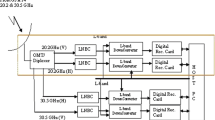Abstract
Results are given of the analysis of several gears of radiometric measurements in the European region, carried out by the European Space Agency. Special attention is given to the attenuation statistics of the worst month in a calendar year and its relation to the yearly statistics. A total of 30 independent worstmonth fading distributions were used in the analysis. Furthermore, fade duration, diurnal variation and frequency dependence of fades are analysed.
Analyse
Pour l’Europe, on donne les résultats de l’analyse de plus ieurs années, de mesures radiométriques sur l’instigation de l’Agence Spatiale Européenne. On s’intéresse particulièrement aux statistiques d’affai blissements, pendant le mois le plus rnauvais au cours d’une année et aux relations existant avec les statistiques annuelles. Un total de 30 distributions d’évanouissements pour les mois les plus mauvais est utilisé dans cette étude. De plus on analyse la durée des évanouissements, les variations diurnes et l’influence de la fréquerice.
Similar content being viewed by others
References
Jarvis (E. G.), Turner (D.). Aerial noise temperature variations at 3,95, 11.75 and 17 GHz due to atmospheric chantes.British Post Office Research Department Report No. 399 (1974).
Author information
Authors and Affiliations
Rights and permissions
About this article
Cite this article
Brussaard, G. Rain attenuation on satellite-earth paths at 11.4 and 14 GHz. Ann. Télécommunic. 32, 514–518 (1977). https://doi.org/10.1007/BF03003505
Received:
Issue Date:
DOI: https://doi.org/10.1007/BF03003505




